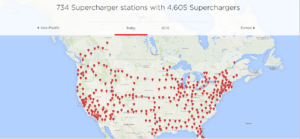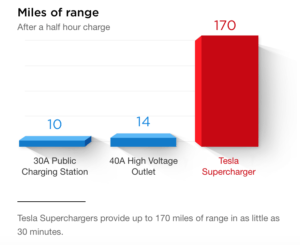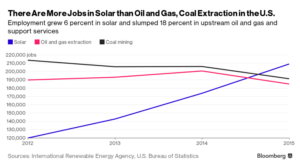“Tesla and the Electric Vehicle Revolution”

Climate change is compelling governments to provide subsidies and incentives to the clean energy industry. This trend impacted Tesla’s operating model by fostering an opportunity for rapid industry expansion and innovation.
“We can break our dependence on oil…and become the first country to have one million electric vehicles on the road by 2015. [1]” – Barack Obama
The impact of pollution is severe, and a 2011 study by MIT found that automobile emissions cause 53,000 premature deaths in the United States every year [2]. Approximately 99% of carbon in auto fuel is emitted as CO2 when burned in an engine and these greenhouse gases harm the environment [3]. In order to combat pollution, in 2009 President Obama revitalized the ‘Recovery Act’ by offering billions of dollars in tax credits to clean energy companies [4]. To specifically tackle auto emissions $2.4 Billion in funding was dedicated to subsidize development and innovation in the electric vehicle (EV) market [5]. Specifically, the Department of Energy dedicated $1.5B to focus on the development of batteries and $900M on the development of EV’s [6].
The tax credits were designed to incentive the rapid growth of the EV industry. As evidenced by the specific areas covered under the Recovery Act, the three major areas pinpointed by the U.S. government for large scale EV innovation were batteries, vehicle production, and charging stations.
In 2003, Elon Musk incorporated ‘Tesla Motors’, a company on a mission to “accelerate the world’s transition to sustainable transport” [7]. Tesla grew rapidly by mixing stylish designs with true EV innovations. Musk saw the opportunity to build a new type of auto company invested in a gasoline free future for automobiles. Today, Tesla has positioned itself as a market leader in innovation and social good.
Tesla’s operating model was impacted by the trend of increasing government spending on clean energy solutions. Tesla commenced a rapid expansion beyond manufacturing EV’s into tangential clean energy markets such as lithium-ion batteries, electric charging stations, and solar panels.
- Since 2010, Tesla has launched two fully electric vehicles: The Model S and X. Tesla is also planning to launch the $35,000 Model 3 in 2017 [8]. The company has had notable success and has sold more than 163,000 cars worldwide since 2008 [9]. The Model X was reported to have a battery capable of going 315 miles on a single charge making it by far the industry leader [10]. The “Model S was named Motor Trend’s 2013 Car of the Year and achieved a 5-star safety rating [11].” A minimum $7,500 tax credit is offered in all states to customers who purchase a Tesla [12].
- Tesla has been investing in state of the art electric charging stations around the country known as ‘Superchargers’. Currently, there are 734 stations with 4,605 Superchargers [13]. The electricity provided at the stations is free to Tesla drivers and their rapid charging rate overshadows competitors. In 2016, President Obama offered $4.5 Billion in subsidies for EV charging station development [14].
- In 2016, Tesla acquired SolarCity, a prominent solar panel company. Tesla plans to install solar panels on household roofs to provide free vehicle electricity in the home [16]. “Fed by state initiatives to spur clean energy… developers are adding workers at record rates to install [solar] rooftop panels. [17]”
- Tesla is currently building its own “Gigafactory”: a $5 Billion 3,200 acre lithium-ion battery factory in the Nevada desert. The company “aims to provide 35GWh of battery power by 2018 – that is more than the combined global production of batteries in 2014.” [18]. Tesla is reportedly receiving $1.4 Billion in tax breaks, free land, and other benefits from the state of Nevada [19].
By innovating in electric vehicles, lithium-ion batteries, solar panels, and charging stations, Tesla is positioning itself to profit from societal efforts to reduce emissions. Advantageously, climate change is compelling governments to provide subsidies and incentives to the clean energy industry. This trend impacted Tesla’s operating model by fostering an opportunity for rapid industry expansion. Tesla’s investments are an attempt to position the company as a clear powerhouse in clean energy. This is a viable long-term business model. Bloomberg Business estimates that by 2040, electric vehicles will account for 35% of all new vehicle sales. They attribute the majority of this growth to innovations in lithium-ion batteries [20].
There are additional steps that Tesla could implement to pursue its mission of sustainable transportation.
- Providing more content on the gravity of pollution caused by gasoline vehicles. There is no literature about the detrimental impact of vehicle CO2 emissions on Tesla’s website. These details could foster a greater emotional response and a sense of urgency amongst automobile consumers.
- Similarly, Tesla provides should provide data on the positive impact they have had on CO2 emissions and forecasts of those effects at scale. Focusing on these trends would further validate the work they are doing in the minds of consumers.
(789 Words)
[1] “Raising The Volt Age,” Scientific American, https://www.scientificamerican.com/article/one-million-electric-vehicles-by-2015/ , Accessed November 2016.
[2] Jennifer Chu, “Study: Air Pollution Causes 200,000 Early Deaths Each Year in the U.S.,” MIT News, August 29, 2013, http://news.mit.edu/2013/study-air-pollution-causes-200000-early-deaths-each-year-in-the-us-0829 , Accessed November 2016.
[3] The Environmental Protection Agency, “Greenhouse Gas Emissions From A Typical Passenger Vehicle”, https://www.epa.gov/sites/production/files/2016-02/documents/420f14040a.pdf , , Accessed November 2016.
[4] Office of the Press Secretary, “Promoting Clean, Renewable Energy: Investments in Wind and Solar.”, The White House, https://www.whitehouse.gov/recovery/innovations/clean-renewable-energy , Accessed November 2016.
[5] Office of the Press Secretary, “President Obama Announces $2.4 Billion in Funding to Support Next Generation Electric Vehicles”, The White House, https://www.whitehouse.gov/the-press-office/president-obama-announces-24-billion-funding-support-next-generation-electric-vehic , Accessed November 2016.
[6] Ibid.
[7] https://www.tesla.com/about
[8] Tesla Motors. “Model 3.” https://www.tesla.com/model3, Accessed November 2016.
[9] Tesla Motors. “Q2 2016 Update Letter.” http://files.shareholder.com/downloads/ABEA-4CW8X0/2563692152x0x903036/562D56A1-5426-4D79-8B99- 3408D1B60226/Q2_16_Update_Letter_-_final.pdf, Accessed November 2016.
[10] John D. Stoll, Tesla Unveils Electric-Car Battery With a 315-Mile Range.”, The Wall Street Journal, http://www.wsj.com/articles/tesla-unveils-battery-with-a-315-mile-range-1471981062 , Accessed November 2016.
[11] Tesla Motors. “About Tesla.” https://www.tesla.com/about/press/releases/tesla-model-s-achieves-best-safety-rating-any-car-ever-tested, Accessed November 2016.
[12] Tesla Motors. “Incentives.” https://www.tesla.com/support/incentives , Accessed November 2016.
[13] Tesla Motors. “Supercharger.” https://www.tesla.com/supercharger , Accessed November 2016.
[14] Office of the Press Secretary, “FACT SHEET: Obama Administration Announces Federal and Private Sector Actions to Accelerate Electric Vehicle Adoption in the United States”, The White House, https://www.whitehouse.gov/the-press-office/2016/07/21/fact-sheet-obama-administration-announces-federal-and-private-sector , Accessed November 2016.
[15] Ibid.
[16] Mike Ramsey, “Tesla Offers To Acquire SolarCity.”, The Wall Street Journal, http://www.wsj.com/articles/tesla-offers-to-acquire-solarcity-1466545551 , Accessed November 2016.
[17] Anna Hirtenstein, “Clean-Energy Jobs Surpass Oil Drilling for First Time in U.S.”, Bloomberg, http://www.bloomberg.com/news/articles/2016-05-25/clean-energy-jobs-surpass-oil-drilling-for-first-time-in-u-s , Accessed November 2016.
[18] Dave Lee, “Inside Tesla’s Gigantic Gigafactory.”, BBC News, http://www.bbc.com/news/technology-36893104 , Accessed November 2016.
[19] Peter Elkind, “Inside Elon Musks $1.4 Billion Score.”, Fortune Magazine, http://fortune.com/inside-elon-musks-billion-dollar-gigafactory/ , Accessed November 2016.
[20] Tom Randall, “Here’s How Electric Cars Will Cause The Next Oil Crisis.”, Bloomberg, http://www.bloomberg.com/features/2016-ev-oil-crisis/, Accessed November 2016.








One concern I have about electric vehicles is their dependance on the existing energy grid. Tesla vehicles are charged from home charging stations or public charging stations which are powered (in most cases) by the existing utility electric grid. In most parts of the country, over 50% of electricity provided to the grid is still sourced from coal or gas, which are not clean, renewable energy sources. Tesla is definitely a step in the right direction, but we need to pay more attention to cleaning the grid. Musk is headed in the right way with the current solar initiatives he is driving through Solar City.
Tesla is a great example of a company that would not exist if climate change were not such an important issue facing our society today. I think it’s great when you see the government put practical programs in place to incentivize the private sector to tackle issues that the government alone can not.
I disagree with Jesse’s suggestions though. I think anyone buying a Tesla, i.e. a wealthy individual that can afford a Tesla, is well aware of the negative impact that gasoline vehicles have on society. At the same time, I question whether or not those driving Tesla’s even care about the positive impact that they are having on society. Tesla has become a sign of wealth and I believe the majority of people that drive Tesla’s do so to make a statement. If they didn’t want to make a statement they would buy a Prius and give the $60,000+ left over to a charity.
On Jesse’s second suggestion, I am not an expert on this but I actually think one possible reason Tesla does not highlight the “benefits” its technology on C02 emissions is that this statement would be questionable. Right now every time you charge a Tesla, the electricity that is used is generated by coal and gas plants which contribute to C02 emissions.
Completely agree with Jake and Jesse on Tesla not existing if not for the government’s renewed interest in climate change and preventing it. It does make you wonder through, with such a reliance on government subsidies, what happens to companies like Tesla when a new administration takes over? With the election literally a few hours away, and the candidates taking rather different stances on energy (with Clinton being very positive towards renewable energy sources [1] and Trump calling climate change a hoax [2[), I really wonder how Tesla’s operations will change based on which candidate takes office in the coming months. Are Tesla and Elon Musk’s dream far enough along that they no longer need the government subsidies? Will things just slow down or could innovation in this area come to a complete stop depending on which candidate takes office?
[1] http://wesa.fm/post/hillary-clinton-talks-jobs-tuition-first-pittsburgh-stump#stream/0
[2] https://twitter.com/realdonaldtrump/status/265895292191248385?lang=en